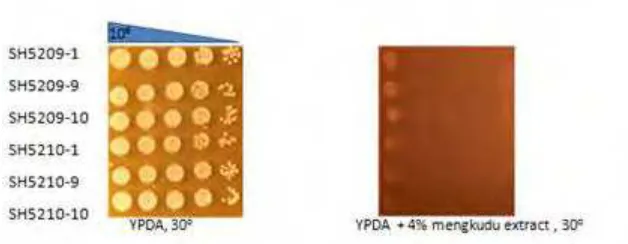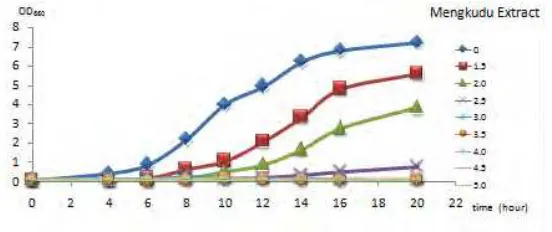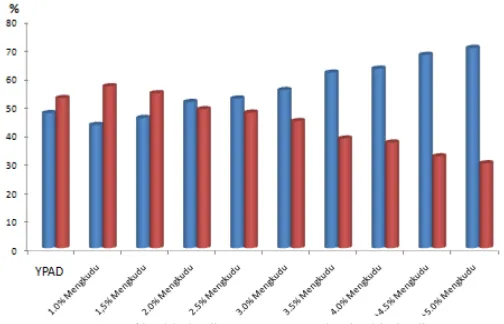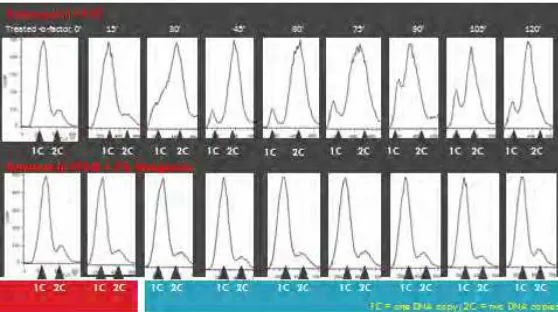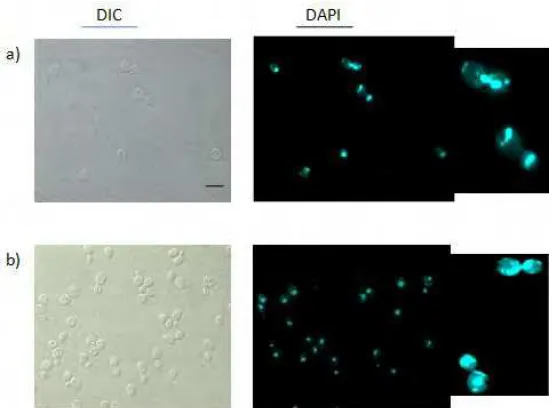O 9
Yeast
Saccharomyces cerevisiae
as Model to Identify
Mengkudu (
Morinda citrifolia
) as an Anticancer
Medicinal Plants Candidates with Antiproliferative
Properties
Hermansyah
Sriwijaya University, Jalan Raya Palembang Pabumulih KM 35, Inderalaya, South Sumatera, Indonesia
Although yeast Saccharomyces cerevisiae is an excellent eukaryotic model organism, however, to use S.cerevisiae cell as a model organism screening drugs is rare. In this research, we used S. cerevisiae to screen antiproliferative properties of mengkudu or noni fruit (Morinda citrifolia). The results showed that 3% w/v extract of mengkudu, but not pare and sukun extracts was capable to inhibit growth of S. cerevisiae effectively. This inhibited phenotypes was confirmed by measuring growth rate of cells in cultures treated with various concentrastions of extracts. Morphologycal analysis using differential interference contrast (DIC) microscopy showed that S. cerevisiae wild type strain FY833 cells was accumulated in the unbudded cells, and further analysis using Fluorescence Activated Cell Sorting (FACS) analysis exhibited that proliferation of cells run unproperly because of cells are arrested in G1 phase, indicating that G1 to S phase transition progression of S. cerevisiae cell cycle was inhibited in the presence of mengkudu extract.
1. Introduction
At least 5,596 genes encoding protein of yeast Saccharomyces cerevisiae has been completely sequenced (Otero et al, 2010). Therefore, the budding yeast S.cerevisiae is being widely used as a model for investigating fundamental celluler mechanisms relevant to all living organisms. The biochemical and physiological functions of higher eukaryotic genes could be studied from S.cerevisiae genes function based on their functional analogies (Foury, 1997). Some advantages using S.cerevisiae are simple to culture in large quantities, and the cell cycle can be easily manipulated both genetically and physiologically.
The budding yeast S.cerevisiae is great help in understanding the celluler function of disease. Many crucial proteins in human were iniatially discovered by studying their homologs in yeast. Many of disease mechanism are affected by genetic and epigenetic alterations in cancer such as cell cycle progression, DNA replication and segregation, maintenance of genomic integrity and stress responses. Therefore, yeast emerges as an attractive model for anticancer drug research (Menacho-Marquez and Murguia, 2007). The cell cycle is a series of events involving the growth, replication, and division of a eukaryotic cell. Replication of DNA occurs in a specific part of the interphase called S phase. S phase is preceded by a gap 1 phase (G1) during which the cell is preparing for DNA synthesis and is followed by a gap 2 (G2) during the cell prepares for mitosis (M). In normal cell, transition progression of cell cycle in each G1, S, G2, and M phases is regulated tightly (Vermeulen et al, 2003; Alberghina et al, 2010). In cancer, there are fundamental alterations in the genetic control of cell division, resulting in an uncontrolled cell proliferation. There is defect in a regulation of
In this research, our goals are to check whether traditional medicinal plant mengkudu or noni fruit (Morinda citrifolia) (Bangun, AP, 2002) affect the growth progression of S.cerevisiae which indicating as antiproliferative and anticancer drug, and to use an excellent model organism, a normal cell S.cerevisiae wild type strain FY833 as preclinical assay for antiproliferative. To my knowledge, publications using of normal cell budding yeast S.cerevisiae as anticancer drug discovery for identification and characterization of traditional medicinal plant is rare.
The results showed that 3% w/v extract of mengkudu was capable to inhibit growth of S.cerevisiae effectively. Furthermore, based upon morphologycal analysis showed that higher concentration of mengkudu extract was added, higher percentage of unbudded cells. Consistent with this result, Fluorescence Activated Cell Sorting (FACS) analysis also showed that in the presence of 3% (w/v) mengkudu extract S.cerevisiae wild type
strain FY833 cells was accumulated in the unbudded cells, indicating that the cell cycle growth progression of S.cerevisiae was inhibited in G1 to S phase. Cells with enlarge of nuclear were also observed in the presence of that mengkudu extract. Taken together, these results indicated that S.cerevisiae is a promising tool for studying identification of antiproliferative character of traditional medicinal plant candidate.
2. Experimental
Extraction using methanol
Mengkudu (M.citrifolia) dried sample (25 g) was extracted by soxletation method using methanol solvent. The extract is concentrated using rotary evaporator under vacuum at room
Spot assay experiment
S.cerevisiae strains BY5209 (= FY833) (Winston et al, 1995) with genotype MATaura3-52 his3-Δ200 leu2Δ1 lys2Δ202 trp1Δ63 cells grown in YPAD medium (consists of 1% bacto yeast extract, 2% bacto pepton, 2% dextrose, 40 mg/100 ml media adenine sulphate) to mid logarithmic phase, suspensions containing equal cell-numbers were prepared on the basis of OD660 and ten-fold serial dilutions were spotted onto YPAD plates supplemented with 3% w/v of mengkudu methanol extract that were incubated for one to two days.
Growth curve
Fresh media (YPAD, YPAD with 3% w/v mengkudu methanol extract) was added overnight culture to a cell density of OD660 0.1. Cultures of S.cerevisiae were grown at 30oC and 145 rpm. Cell growth were measured as OD660 every 2 hours until reach
or stationary phase.
Morphology observation
Cells grown in YPAD and YPAD with 3% w/v mengkudu methanol extract) to an OD660 = 1.0 were concentrated twenty-fold in sterilezed water. Then immediately analyzed with a fluorescence microscope (BX61-34-FL-I-D, Olympus) using a BF and DAPI filter (Olympus), CCD camera (CCD-Exi, Molecular Devices) and MetaMorph version 6.1 software (Molecular Devices).
Synchronization of cell cycle
Cells grown in YPAD to mid logarithmic phase were arrested in G1
3% (w/v) mengkudu extract. At least 500 cells were counted to determine the percentage of budded cells.
FACS (Fluorescent-Activated Cell Sorting) analysis (Haase and Lew,
1997).
An 0.25 ml aliquot of yeast cells (OD660 = 1.0) grown in YPAD broth without and with methanol extract 3% (w/v) mengkudu extract was harvested by centrifugation, and, after being resuspended by gentle vortexing, fixed with cold ethanol (-20oC) for at least 12
pelleted and resuspended in the dark with 300 l of 0.2 M Tris-HCl
(pH 7.5) with 100 g/ml propidium iodide on ice, added 400 µl of
shown). Opposite with above result, in the presence of mengkudu extract, in YPAD agar medium, cells are clearly sensitive phenotype in the presence of 4%(w/v) mengkudu extract. While using YPD broth medium, growth curve of S.cerevisiae cells showed cells capability to grow, the result indicated that the growth is weaker from 0% to 3% (w/v) mengkudu extract-present, and from in the presence of 3% to 5% (w/v) cells capability to grow is completly no growth (Figure 1 and Figure 2).
Figure 1. Spot analysis of S.cerevisiae for mengkudu, pare, and sukun extract. In the presence of 4%(w/v) of mengkudu the cells are sensitive.
preventive effect at the initial stage of carcinogenesis, this hyphotesis was studying furthermore.
Figure 2. Growth curve S.cerevisiae in various concentrations (0-5% w/v) of
mengkudu extract In Figure a shows in the presence of mengkudu extract 0-3%(w/v) growth of cells is slower, while 3-5%(w/v) growth almost stopped.
Unbudded cells are more than budded cells
Figure 3. Comparison of budded cells percentage and unbudded cells percentage. In the presence of mengkudu extract induced inhibited growth of budding. At least 500 cells grown to mid log phase were checked. Blue bar indicates unbudded cells
form, and red bar indicates budded cells form.
FACS analysis revealed that G1 to S transision was arrested
To confirm the inhibited growth of S.cerevisiae cells was treated with mengkudu extract, we conducted FACS (fluorescence activated cell sorting) analysis.
Figure 4. FACS analysis. 3%(w/v) mengkudu extract unbudded cells (1C) inhibited G1 to S progression. 1C, one DNA copy; 2C, two DNA copies.
First, S.cerevisiae cells were arrested using the mating pheromone
alpha α fa to to get s h o ized ells i G phase Fut he ,
1999). Effect of mengkudu extracts to the S.cerevsiae cell cycle were observed after 90 minute release into broth media containing each of those extracts. In the presence of mengkudu extract as in Figure 4b S.cerevisiae cells were arrested in G1 phase, indicated
that progression transition of G1 to S is not run properly. This make proliferation or increasion of cell number of S.cerevisiae cells are stopped.
Enlarge nuclear of cells
fragmented vacuolar cell (Hermansyah et al, 2009; 2010) or cells treated with Lyc, a plant-derived natural alkaloid product showing cells typically had a fragmented nucleus (Qaddouri et al, 2009).
Figure 5. Comparison of morpholical cells, cells were grown in YPAD without and with mengkudu extract. Figure shows enlarged nuclear in cells treated with
mengkudu extract. Bar 1µm.
4. Conclussions
This research exhibits usage of budding yeast S.cerevisae as a useful
References :
[1] Otero, J.M., Vongsanak, W., Asadollahi, M.A., Olivares-Hernades-R., Maury, J., Farinelli, L., Barlocher, L., Osteras, M., Schalk, M., Clark, A., and Nielson, J., BMC Genomics 11 (2010) 723.
[2] Foury, F., Gene 195(1) 1997), 1-10. review
[3] Menacho-Marquez, M. And Murgui, J.R., Clin. Transl. Oncol. 9(4) (2007) 221-8. Review.
[4] Vermeulen, K., Van Bockstaele, D., and Berneman, Z.N, Cell Prolif. 36 (2003) 131-149
[5] Alberghina, L., Mavelli, G., Drovandi, G., Palumbo, P., Pessina, S., Tripodi, F., Coccetti, P., Vanoni, M., Biotechnology Adv. (2011) 07.010
[6] Bangun, A.P., and Saworno, B., Agromedia Pustaka, (2002).
[7] Winston F., Dollard C. and Ricupero-Hovasse, S.L. Yeast 11 (1995) 53-55. [8] Haase, S.B. and Lew, D.J. Methods Enzymol. 283 (1997) 322-332. [9] Wang, M.Y. and Su, C., Ann N. Y. Acad. Sci. 952(2001) 161-8
[10] Nakashima, A., Maruki, Y., Imamura, Y., Kondo, C., Kawamata, T., Kawanishi, I., Takata, H., Matsuura, A., Lee, K.S., Kikkawa, U., Ohsumi, Y., Yonezawa, K., Kamada, Y., PloS One. 21;3(5)e2223.
[11] Qaddouri, B., Guaadaoui, A., Bellirou, A., Hamal, A., Melhaoui, A., Brown, G.W., and Bellaoui, M., eCAM (2009) 1-5.
[12] Futcher, B., Methods in Cell Science 21(1999) 79-86.
